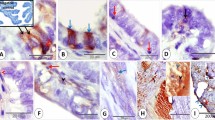Abstract
Stromal cells in the lamina propria of the human oviduct mucosa are unique cells that can differentiate into decidual cells during ectopic pregnancy in the oviduct. The nature of stromal cells is still unknown. In the present study, we investigated human oviductal stromal cells with transmission electron microscopy and immunohistochemistry and revealed that they had ultrastructural features similar to myofibroblasts and expressed alpha-smooth muscle actin, a marker used to identify myofibroblasts. Primary cilia were also one of the characteristic profiles of the stromal cells. These findings showed that the connective tissue-stromal cells in the human oviduct mucosa are myofibroblasts. They are considered to play an important role in the transport of oocytes by bringing about contraction of the mucosal folds.
Similar content being viewed by others
References
Gabbiani G, Ryan GB, Majno G (1971) Presence of modified fibroblasts in granulation tissue and their possible role in wound contraction. Experientia (Basel) 27:549–550
Majno G, Gabbiani G, Hirschel BJ, Ryan GB, Statkov PR (1971) Contraction of granulation tissue in vitro: similarity to smooth muscle. Science 173:548–550
Eyden B (2005) The myofibroblast: a study of normal, reactive and neoplastic tissues, with an emphasis on ultrastructure. Part 1: Normal and reactive cells. J Submicrosc Cytol Pathol 37:109–204
Darby IA, Hewitson TD (2007) Fibroblast differentiation in wound healing and fibrosis. Int Rev Cytol 257:143–179
Skalli O, Ropraz P, Trzeciak A, Benzonana G, Gillessen D, Gabbiani G (1986) A monoclonal antibody against α-smooth muscle actin. A new probe for smooth muscle differentiation. J Cell Biol 103:2787–2796
Hinz B, Celetta G, Tomasek JJ, Gabbiani G, Chaponnier C (2001) Alpha-smooth muscle actin expression upregulates fibroblast contractile activity. Mol Biol Cell 12:2730–2741
Yamazaki K, Eyden BP (1996) Ultrastructural and immunohistochemical studies of stromal cells in lamina propria of human fallopian tube ampullar mucosa: the recognition of “CD34 positive reticular network” and its putative function for immune surveillance. J Submicrosc Cytol Pathol 28:325–337
Popescu LM, Ciontea SM, Cretoiu D, Hinescu ME, Radu E, Ionescu N, Ceausu M, Gherghiceanu M, Braga RI, Vasilescu F, Zagrean L, Ardeleanu C (2005) Novel type of interstitial cell (Cajal-like) in human fallopian tube. J Cell Mol Med 9:479–523
Walter I (1998) Myofibroblasts in the mucosal layer of the uterine tube. Ital J Anat Embryol 103(suppl 1):259–266
Kuroda N, Inui Y, Ohara M, Hirouchi T, Mizuno K, Kubo A, Hayashi Y, Enzan H, Lee GH (2007) Hyaline globule-like structures in undifferentiated sarcoma cells of malignant mullerian mixed tumor of the fallopian tube. Med Mol Morphol 40:46–49
Hagiwara H, Aoki T, Ohwada N, Fujimoto T (1997) Development of striated rootlets during ciliogenesis in the human oviduct epithelium. Cell Tissue Res 290:39–42
Hagiwara H, Kano A, Aoki T, Ohwada N (2000) Immunocytochemistry of the striated rootlets associated with solitary cilia in human oviductal secretory cells. Histochem Cell Biol 114:205–212
Hagiwara H, Tajika Y, Matsuzaki T, Suzuki T, Aoki T, Takata K (2006) Localization of Golgi 58 K protein (formiminotransferase cyclodeaminase) to the centrosome. Histochem Cell Biol 126: 251–259
Singer II, Kawka DW, Kazazis DM, Clark RA (1984) In vivo codistribution of fibronectin and actin fibers in granulation tissue: immunofluorescence and electron microscope studies of the fibronexus at the myofibroblast surface. J Cell Biol 98:2091–2106
Schürch W, Seemayer TA, Gabbiani G (1998) The myofibroblast: a quarter century after its discovery. Am J Surg Pathol 22: 141–147
Serini G, Bochaton-Piallat ML, Ropraz P, Geinoz A, Borsi L, Zardi L, Gabbiani G (1998) The fibronectin domain ED-A is crucial for myofibroblastic phenotype induction by transforming growth factor-beta1. J Cell Biol 142:873–881
Kuroda N, Miyazaki E, Hayashi Y, Toi M, Hiroi M, Enzan H (2004) The disappearance of CD34-positive and alpha-smooth muscle actin-positive stromal cells associated with human intrauterine and tubal pregnancies. Histol Histopathol 19:707–713
Kobayashi K, Kubota T, Aso T (1998) Study on myofibroblast differentiation in the stromal cells of Wharton’s jelly: expression and localization of alpha-smooth muscle actin. Early Hum Dev 51:223–233
Pereira RO, de Carvalho TM, Barbosa HS, Porto LC, de Carvalho L (2004) Enhancement of lipid bodies during differentiation of skeletal myofibroblasts of rat’s fetus in vitro. In Vitro Cell Dev Biol Anim 40:1–3
Satir P, Christensen ST (2007) Overview of structure and function of mammalian cilia. Annu Rev Physiol 69:377–400
Blacque OE, Leroux MR (2006) Bardet-Biedl syndrome: an emerging pathomechanism of intracellular transport. Cell Mol Life Sci 63:2145–2161
Montes GS, Zugaib M, Joazeiro PP, Varayoud J, Ramos JG, Munoz-de-Toro M, Luque EH (2002) Phenotypic modulation of fibroblastic cells in the mucous layer of the human uterine cervix at term. Reproduction 124:783–790
Oliver C, Montes MJ, Galindo JA, Ruiz C, Olivares EG (1999) Human decidual stromal cells express alpha-smooth muscle actin and show ultrastructural similarities with myofibroblasts. Hum Reprod 14:1599–1605
Kuroda N, Nakayama H, Miyazaki E, Hayashi Y, Toi M, Hiroi M, Enzan H (2004) Distribution and role of CD34-positive stromal cells and myofibroblasts in human normal testicular stroma. Histol Histopathol 19:743–751
Author information
Authors and Affiliations
Corresponding author
Rights and permissions
About this article
Cite this article
Hagiwara, H., Ohwada, N., Aoki, T. et al. Immunohistochemical and electron microscopic observations of stromal cells in the human oviduct mucosa. Med Mol Morphol 41, 221–226 (2008). https://doi.org/10.1007/s00795-008-0422-y
Received:
Accepted:
Published:
Issue Date:
DOI: https://doi.org/10.1007/s00795-008-0422-y



